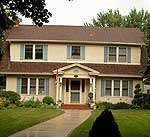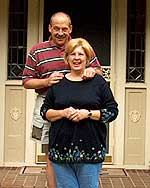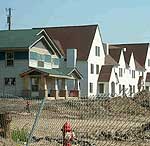By Andrew Haeg
Minnesota Public Radio
August 26, 2002
The price of a home in the Twin Cities, St. Cloud and Rochester has risen at double digit rates for at least four years. Many homeowners in those areas have seen their net worth balloon. But others trying to buy their first house have watched as the prices of even modest homes have soared beyond their reach. The rapid increase in prices has some wondering if the housing market - like the late '90s dot-com sector - is in the midst of a bubble that's ready to burst.
| |
|
|
|
||
Florence and Jim Funk just sold their Dutch colonial at 1397 Summit Ave. in St. Paul. At just over 2,200 square feet, it's a modest structure for this boulevard of mansions.
Six years ago, the Funks bought the house for $240,000 - less than the asking price. It had been on the market for over a year.
When the Funks recently thought of selling, they imagined the house would fetch, at the most, $350,000. But Florence Funk says after a visit from a real estate agent, that number changed.
"She was showing us houses that were our size, or a little bit smaller or a little bit bigger, that were selling for $550,000 or $580,000. She said, 'We could list your house for as much as $500,000.' And we just started to laugh, because we thought it was so terribly funny," Funk says. "We thought this was crazy."
It was only slightly crazy. The Funks ended up putting their house on the market for $450,000, more than they ever believed possible. They got three bids in two days, and finally sold their house for $7,000 more than the asking price.
| |
|
|
|
||
That, as Jim Funk says, is almost double what they bought it for just six years ago.
"If we look at what we paid and what we sold for today, it's 17 percent a year appreciation, which just amazed me. I have never dreamed that," Funk says.
OTHERS PRICED OUT AS PRICES RISE
Across town in the Powderhorn Park neighborhood of south Minneapolis, Nekeisia Booyer is still waiting to find a house she can afford. She's a single mother and a manager at the Employment Action Center in Minneapolis.
After her son was born a year ago, she wanted to find a house for the two of them. But she's watched with frustration as the prices of homes have fluttered beyond her reach.
"When they threw up signs where they were probably building new townhomes in the area where I'm living now, and seeing houses on the market, they attached the word 'affordability' to them. I'm seeing the dollar amount of $140,000, or even $120,000. By whose standards is that affordable living? I'm not in that category," says Booyer.
| |
|
|
|
||
Experts say the median price of a home in the Twin Cities is affordable - at the median income. But for households like Booyer's, with one person earning a moderate income, home prices are often too expensive. Booyer says she wishes she could buy a home, but the prices are prohibitive.
"You have people who've been renting, such as myself, for a good majority of my life, who are trying to get to that next level. But because of the cost of housing it's quite a hindrance," Booyer says.
Florence and Jim Funk and Nekeisia Booyer tell two very different stories. But they are flip sides of the same coin. The higher housing prices go, more people like the Funks see their wealth rise with the price of their homes. But at the same time, aspiring homeowners like Booyer see their dreams deferred.
Home prices have risen dramatically in some parts of the state, but not all.
"The house price story around the state is really a tale of three different types of cities," says Kit Hadley, commissioner of the Minnesota Housing Finance Agency.
"In the 11 counties surrounding Minneapolis and St. Paul, in the greater Rochester area, the greater St. Cloud area, we've not only seen prices go up over the decade, but in recent years we've seen double digit increases in prices year to year," Hadley says.
|
"I'm seeing the dollar amount of $140,000, or even $120,000. By whose standards is that affordable living? I'm not in that category."
- Nekeisia Booyer |
But she says prices in other areas are either stable or declining.
"And it is an indication of either declining population and household growth, or stable population and household growth. And you can barely believe that those types of real estate markets exist in a single state," Hadley says.
LOW RATES, RISING INCOME FUEL BOOM
Home prices have soared in Minnesota in the past.
George Karvel, professor of real estate at the University of St. Thomas, says the Twin Cities saw similar increases in home prices during the 1970s, driven by different forces than today.
"Not only by demand for those houses, but by generally high rates of inflation throughout the entire economy," Karvel says. "Today, the demand for housing is driven by the fact that interest rates are at historic lows, making homes more affordable for most families than they have ever been in the last 30 to 40 years."
Since 1990, home ownership in Minnesota has jumped from 72 percent to 75 percent, the second highest in the nation. Demand has heavily outstripped supply in many areas. Even after the dot-com bust, the recession, Sept. 11, and the recent spate of corporate scandals, home prices have continued to rise.
| |
|
|
|
||
In July, a median priced home in the Twin Cities rose to roughly $190,000, up from about $170,000 at the same time a year ago. The housing market's strength and stamina have baffled even veteran real estate agents.
"It's difficult to really come up with what the price should be," says Rachel Nelson, who has sold homes for Edina Realty in St. Paul for the past 21 years.
Prices in the neighborhoods around her Grand Ave. office have ballooned in recent years, leaving her groping for guideposts to pricing a home.
"It becomes more of an art than a science. Who are you working with? What are the personalities? Are they very conservative, saying, 'We're making enough money the way it is, let's put it on where we think it's a true price for it, and if we get more than one offer, fabulous,' Nelson says. "And then there's other people that say, 'I don't care. If it doesn't sell this year I'll put it on next year.' And they'll try for higher. And the last few years, it seems like all of these people are getting what they're looking for."
Nelson says year after year, sellers will price their houses well above what she suggests.
"I keep saying, 'No way. This is totally unrealistic.' And by the end of the week, they'll have two or three offers," says Nelson.
THE BUBBLE QUESTION
Persistently rising prices - amid a sputtering economy - have lately had economists and others warning of a bubble in housing prices.
"A bubble is speculation and mythology," says real estate expert George Karvel, who argues that some simple facts dispel the notion that home values have risen to unsustainable levels.
One fact is - interest rates are now as low they've been since 1966. Another - over the 1990s, Minnesota's median household income grew an average of 17 percent, adjusted for inflation. Finally, unemployment remains low, around four percent in Minnesota, despite months of economic stress.
Housing demand has reportedly begun to slow down in pockets around the Twin Cities, and realtors say the average number of days a house spends on the market is rising.
But Karvel sees no evidence of a bubble set to burst. For that to occur, he says interest rates would have to rise sharply, driving down demand. And prices for labor and construction materials would have to fall.
"If all of those events came together, you would have sharply lower housing costs. There's absolutely nothing on the horizon to indicate that any cataclysm of that magnitude would be likely to occur that would cause any collapse in prices," says Karvel.
Recent remarks from Federal Reserve officials suggest low interest rates are likely to continue.
If interest rates and unemployment remain low, the strong real estate markets in several of the state's big cities seem likely to persist.
More from MPRMore Information




